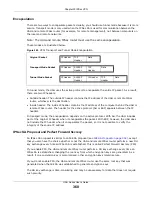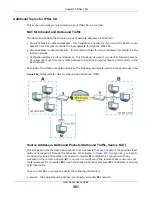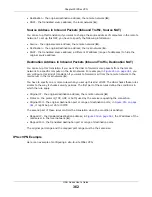
Chapter 30 IPSec VPN
UAG Series User’s Guide
355
Figure 245
IKE SA: Main Negotiation Mode, Steps 1 - 2: IKE SA Proposal
The UAG sends one or more proposals to the remote IPSec router. (In some devices, you can only
set up one proposal.) Each proposal consists of an encryption algorithm, authentication algorithm,
and DH key group that the UAG wants to use in the IKE SA. The remote IPSec router selects an
acceptable proposal and sends the accepted proposal back to the UAG. If the remote IPSec router
rejects all of the proposals, the UAG and remote IPSec router cannot establish an IKE SA.
Note: Both routers must use the same encryption algorithm, authentication algorithm,
and DH key group.
In most UAGs, you can select one of the following encryption algorithms for each proposal. The
algorithms are listed in order from weakest to strongest.
• Data Encryption Standard (DES) is a widely used method of data encryption. It applies a 56-bit
key to each 64-bit block of data.
• Triple DES (3DES) is a variant of DES. It iterates three times with three separate keys, effectively
tripling the strength of DES.
• Advanced Encryption Standard (AES) is a newer method of data encryption that also uses a
secret key. AES applies a 128-bit key to 128-bit blocks of data. It is faster than 3DES.
Some UAGs also offer stronger forms of AES that apply 192-bit or 256-bit keys to 128-bit blocks of
data.
In most UAGs, you can select one of the following authentication algorithms for each proposal. The
algorithms are listed in order from weakest to strongest.
• MD5 (Message Digest 5) produces a 128-bit digest to authenticate packet data.
• SHA1 (Secure Hash Algorithm) produces a 160-bit digest to authenticate packet data.
• SHA256 (Secure Hash Algorithm) produces a 256-bit digest to authenticate packet data.
• SHA512 (Secure Hash Algorithm) produces a 512-bit digest to authenticate packet data.
See
Diffie-Hellman (DH) Key Exchange on page 355
for more information about DH key groups.
Diffie-Hellman (DH) Key Exchange
The UAG and the remote IPSec router use DH public-key cryptography to establish a shared secret.
The shared secret is then used to generate encryption keys for the IKE SA and IPSec SA. In main
mode, this is done in steps 3 and 4, as illustrated next.
One or more proposals, each one consisting of:
- encryption algorithm
- authentication algorithm
- Diffie-Hellman key group
1
2
X
Y
Содержание UAG2100
Страница 171: ...Chapter 10 Interfaces UAG Series User s Guide 171 Figure 118 Configuration Network Interface PPP Add ...
Страница 185: ...Chapter 10 Interfaces UAG Series User s Guide 185 Figure 124 Configuration Network Interface Bridge Add ...
Страница 247: ...Chapter 19 UPnP UAG Series User s Guide 247 Figure 166 Network Connections My Network Places Properties Example ...
Страница 319: ...Chapter 26 Billing UAG Series User s Guide 319 Figure 226 Configuration Billing Payment Service Desktop View ...
Страница 320: ...Chapter 26 Billing UAG Series User s Guide 320 Figure 227 Configuration Billing Payment Service Mobile View ...
Страница 342: ...Chapter 30 IPSec VPN UAG Series User s Guide 342 Figure 242 Configuration VPN IPSec VPN VPN Connection Add Edit ...
Страница 349: ...Chapter 30 IPSec VPN UAG Series User s Guide 349 Figure 244 Configuration VPN IPSec VPN VPN Gateway Add Edit ...
Страница 365: ...Chapter 30 IPSec VPN UAG Series User s Guide 365 ...
Страница 507: ...Chapter 46 System UAG Series User s Guide 507 Figure 341 Configuration System WWW Login Page Desktop View ...
Страница 535: ...Chapter 47 Log and Report UAG Series User s Guide 535 Figure 375 Configuration Log Report Email Daily Report ...
Страница 539: ...Chapter 47 Log and Report UAG Series User s Guide 539 Figure 377 Configuration Log Report Log Settings Edit System Log ...
Страница 602: ...Appendix B Legal Information UAG Series User s Guide 602 Environmental Product Declaration ...






























